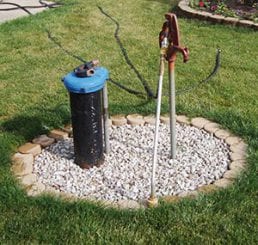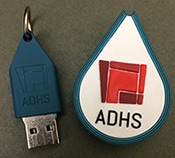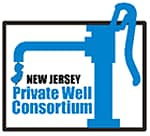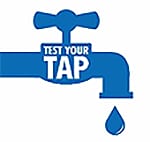Success Stories for Private Well Projects

Read success stories from state and county health departments we funded in 2015-2020 to improve the efficiency and effectiveness of their safe drinking water programs.
Recipients worked to understand the service needs of U.S. residents relying on federally unregulated drinking water sources and systems and to support public health agency efforts to address those needs.
Recipients of CDC’s Safe Water funding
- Coordinated with state public health and private laboratories (11 recipients) to test water samples, share, and organize test results.
- Identified 210,000 private well records and entered them in digital format.
- Collected 102,000 private well water quality records and entered them in digital format.
- Distributed 9,060 free drinking water sample kits in private well outreach activities in U.S. communities.
- Collected and tested 26,427 well water samples and found that 4,346 serving ~11,000 people had high levels of contaminants.
- Created or amended 86 educational materials addressing contaminants and risks to drinking water sources and systems from contaminants, emergency events, and natural disasters.
- Conducted 484 outreach events to promote well testing and inform the public about drinking water safety.
- Presented at 126 conferences and meetings to share program achievements.
- Developed 193 partnerships through state and regional coalitions to reduce hazardous exposures.

Arizona Department of Health Services (ADHS) – ADHS developed and staffed a drinking water program to respond to drinking water contaminant concerns from private well owners. ADHS also used Safe Water support to develop resources for communities, state, and local agencies on well testing, including emergency guidance on private wells and well maintenance tips. A new ADHS websiteexternal icon houses these resources as well as outreach materialsexternal icon created for well owners in response to community concerns. In 2017, ADHS used Safe Water support to provide bilingual emergency response materials when a sewage pipeline ruptured in Santa Cruz County, Arizona.
ADHS collaborated with water quality specialists at the University of Arizona to conduct well workshops for residents. From 2016 to July 2018, ADHS held workshops in eight counties for almost 600 attendees. In 2017, 94% of attendees said the workshops met their expectations. To expand outreach, ADHS used USB drives to share its tools at workshops, at community health fairs, and with new well owners registered with the Arizona Department of Water Resources.
Connecticut Department of Public Health (CT DPH) – CDC supported CT DPH to collaborate with local health departments and collect 674 private well samples. Seven percent of the samples exceeded the maximum contaminant level (MCL) for arsenic or uranium. In 2016, the Safe Water program supported CT DPH to share the sampling results with the U.S. Geological Survey (USGS). USGSexternal icon found a higher percentage of sample results from some bedrock types exceeded the MCL for arsenic or uranium. USGS also found isolated cases of very high arsenic and uranium in bedrock usually associated with low levels of contamination.
CT DPH used the USGS findings to reaffirm messaging that the state’s 322,600 private well owners should get their water tested. From September 2015 to August 2018, CT DPH hosted private well water fairs across Connecticut and collected 700 additional samples from private wells. CT DPH continues working with USGS to incorporate new data and refine the bedrock mapping to show the prevalence of arsenic and uranium in private wells.
Delta County (CO) Health Department – Under the leadership of the Delta County Colorado Health Department, the West Central Public Health Partnership (WCPHP) developed a comprehensive database of groundwater quality information collected throughout the six counties in the partnership region. Before the Safe Water project, there was no comprehensive regional approach to private drinking water quality within WCPHP region. This work would not have been possible without the CDC support and technical assistance.
Property owners and other interested parties can now access and use the groundwater quality information through a user-friendly interactive websiteexternal icon. WCPHP proactively identified areas where there is a high potential for contamination (e.g., arsenic) in the aquifer and alerted well owners to the existing health hazards.
The Safe Water program helped provide incentive and motivation to increase well testing among well owners that do not have the resources to sample their well water.
Gaston County (NC) Department of Health and Human Services (GCDHHS) – Healthy Wells Program – The GCDHHS Healthy Wells Program used Safe Water funding to partner with faculty and students from the University of North Carolina at Charlotte (UNCC) to create an electronic, geocoded database for 8,087 private wells from data in paper permits. The partners developed an application to facilitate downloading and synchronizing of coordinates. Well owners can now enter permit information and microbial and chemical test results in the public database. UNCC students also developed and distributed ~1,500 brochures to promote private well testing and sampled 706 wells for total coliform and E. coli.
GCDHHS partnered with the state public health laboratory to electronically share test results of inorganic contaminants in new county wells. These achievements improved the Healthy Wells Program’s services to protect private well users in Gaston County.
Indiana State Department of Health (ISDH) – As part of the Safe Water program, ISDH collaborated with 60 state and local environmental public health officials to collect nearly 700 water quality tests from individual wells in targeted communities. These interactions with community households allowed ISDH to educate well owners about contamination and provide technical assistance on safe drinking water interventions that otherwise would not have been possible.
The Safe Water program empowered ISDH to improve local environmental public health capacity and increase collaboration between state and local agencies to serve communities who have no other drinking water protection available. The Safe Water program helped ISDH host five interns, organize three workshops, develop six support networks to address groundwater contamination, respond to environmental emergencies that affect private water supplies in nine counties, attend 35 professional development and outreach events, and present at 18 education events.
La Crosse County (WI) Health Department (LCCHD) – Through the Safe Water program, LCCHD supported certification of laboratory staff to test for lead and arsenic, reduced testing prices in La Crosse and partner counties, and created a water quality labexternal icon in Vernon County, Wisconsin. These activities connected residents to needed safe water services in the state’s western region. LCCHD collaborated with five counties in western Wisconsin to improve the health of residents consuming well water. Collaborating counties reviewed program data and gaps, formulated recommendations for changes, developed outreach resources, and worked to educate and empower private well owners to test their well water.
To overcome transportation barriers, LCCHD staff visited communities outside of their laboratory service area to provide education and sampling materials and collect water samples. Communities responded positively to these services. Western Wisconsin county partners hope to establish regular on-site collections to sustain these sampling services.
Louisiana Private Well Initiative (PWI) – Using Safe Water support, PWI launched the Private Well Owner Network (PWON) for Louisiana residents. PWONexternal icon connects private well owners with licensed well professionals and certified laboratories to guide residents on well protection and maintenance. PWON also houses a mapping toolexternal icon for viewing water quality data of area aquifers.
PWI established strong partnerships with state, federal, and nonprofit agencies such as the following:
- Louisiana Flood Plain Management Association/Disaster Response Team for outreach to flood-impacted well owners.
- Louisiana Department of Health’s Bureau of Family Health to educate well owners with infants about nitrates and health.
- Louisiana Groundwater Association and Rural Water Association to educate licensed well professionals during continuing education events.
- Public health units, federally qualified health centers, rural health clinics, and traveling nurses to deliver outreach materials to healthcare providers and patients.
CDC support made collaborations and services delivery possible.
Madison County (NY) Department of Health (MCDOH) – MCDOH used Safe Water support to conduct individual water system assessments and water testing to identify areas in the county where contaminants may be present. MCDOH sampled more than 400 water systems and found that 39% of the individual water supplies tested positive for total coliform bacteria. Staff assessed drilled wells and their respective well cap type and found that drilled wells with sanitary well caps were 67% less likely to be contaminated by bacteria than drilled wells with an unsanitary well cap. MCDOH provided well disinfection guidelines and information on well drillers who perform disinfection services to households with positive bacteria results. As a result, 40% of households disinfected their well, 61% replaced their well cap, and 35% requested resampling. The well cap dataexternal icon can be found on MCDOH’s Private Individual Water Testing Servicesexternal icon page along with an interactive map of where contaminants may be present.
Michigan Department of Health and Human Services (MDHHS) – Through the Safe Water program, MDHHS identified gaps in well owner knowledge and private drinking water programs across the state.
Using the Michigan Behavioral Risk Factor Surveillance Survey, MDHHS recruited and offered well owners a water test kit. MDHHS followed up with 69 well owners to evaluate their experience with the effectiveness, accessibility, and quality of local and state resources for well water testing. Survey results revealed the need for well owner outreach, so MDHHS updated coliform bacteria and nitrate fact sheets and developed fact sheets on well maintenance and testing.
MDHHS also interviewed staff from local health departments (LHDs), nongovernmental organizations, and the Department of Environmental Quality to understand local ordinances and identify gaps in private well and onsite wastewater programs.
MDHHS used Safe Water support to create a website and interactive mapping platform for public officials, LHDs, and the public to obtain resources and identify best practices and recommendations for private wells.
Missouri Department of Health and Senior Services (MDHSS) – MDHSS offers water sampling through local public health agencies (LPHAs) in all 115 counties. In 2015, the extent of LPHA participation in drinking water activities was largely unknown. Using Safe Water support, MDHSS assessed safe drinking water activities statewide and established a sustainable private drinking water program (PDWP).
The assessment revealed the need for education and training in LPHAs, so MDHSS collaborated with the State Public Health Laboratory to fine-tune user-friendly laboratory request forms, pdf icon[PDF 1.33 MB]external icon water sampling instructions, pdf icon[PDF – 179 KB]external icon and disinfection recommendations. As part of PDWP, MDHSS conducts county well surveys to understand water quality issues and learn how to help the public with private drinking water issues. PDWP developed a websiteexternal icon to house new educational materials for LPHAs and well owners.
Learning from the CDC Safe Water program and from other recipients was beneficial in developing PDWP. MDHSS advances to improve private drinking water related services would not have been possible without support provided by the program.

New Jersey Department of Health (NJDOH) – CDC’s Safe Water Program empowered New Jersey’s Private Well Program to form the Private Well Consortium. Professionals from diverse state and local institutions and private industry convene to discuss effective means for reducing hazardous drinking water exposures for private well owners. The New Jersey Private Well Program has hosted the consortium since 2015, and attendance is growing every year.
Consortium meetings consist of presentations plus 1 hour of open discussion. Presentations have included updates on
- New Jersey Private Well Program outreach and testing events.
- Private well water research in New Jersey from Columbia and Rutgers University.
- New Jersey’s Private Well Testing Act and new maximum contaminant levels.
- Radioactive hazards associated with water treatment tanks.
A consortium subcommittee discusses policy options for certification of water treatment professionals. The subcommittee also provides input from stakeholders representing industry and occupational perspectives. Safe Water support helped make the Private Well Consortium sustainable.
New Mexico Department of Health (NMDOH) – The Safe Water program helped NMDOH achieve greater success with their private well program. Metal identification tags have been required for new wells drilled in New Mexico since June 2017. Safe Water funds made it possible for NMDOH to purchase well tags and encourage owners to tag wells drilled before June 2017. Well tagging can help link water-quality information, well geographic coordinates, and owner name to specific wells. Well tagging can also help standardize a private well database and simplify disaster preparedness and response for events that may affect private well water quality.
New York State Department of Health (NYSDOH) – NYSDOH staff used Safe Water support to enhance the process of private well identification in the state. An inventory of private wells was created using GIS partner maps to show well locations in specific vulnerable areas such as in Karst geographical zones near concentrated animal feeding operations and wells in 100- and 500-year flood zones. The new maps make it possible to identify locations of vulnerable wells and aid in the implementation of NYSDOH’s new Private Well Sampling Pilot Program.
The Private Well Sampling Pilot Program combines qualitative interview data and quantitative well sampling data to better inform NYSDOH staff of what resources are needed by well users. This pilot program informs future outreach materials for well owners and aims to increase stewardship of the population using wells.
NYSDOH staff are working on a media campaign to encourage well users and their families to routinely test their water.
North Carolina Department of Health and Human Services, Occupational and Environmental Epidemiology (OEE) – Private Well and Health Program (PWHP) – CDC’s Safe Water program supported PWHP to improve the efficiency of private well data collection and management. The support helped strengthen a partnership between the State Laboratory of Public Health and PWHP to regularly share private well water data in an electronic spreadsheet format. This allowed PWHP to electronically manage statewide well water data instead of receiving PDF reports. PWHP received results spanning 2010 to 2018 from wells sampled in North Carolina.
In addition, staff from OEE and PWHP collaborated to connect with 19 local health departments and facilitate the gathering of new well water results not conducted with the State Laboratory of Public Health.
Oregon Health Authority (OHA) – Domestic Well Safety Program (DWSP) – The Safe Water program supported OHA to improve efficiency of its program for domestic well stewardship and water security. DWSP awards annual grants to local public health authorities (LPHAs) for these efforts. In 2018, six LPHAs expressed interest in the grant, but only one applied. To learn about application barriers, DWSP collaborated with OHA evaluators to assess past recipients and LPHAs who expressed interest but did not apply. The assessment identified several limiting factors, and DWSP used the findings to improve the application process; in 2019, DWSP will
- Post the grant announcement earlier to avoid winter holidays.
- Increase the application period from 8 to 12 weeks.
- Extend the project period from 1 to 2 years.
DWSP will also increase funding from $7,000 to $10,000 and provide an additional $5,000 in year 2 to conduct follow-up and evaluation.
Tacoma Pierce County (WA) Health Department (TPCHD) – Safe Drinking Water Program (SDWP) – The Safe Water program helped TPCHD increase the efficiency and sustainability of its SDWP. The program has regulatory authority over small water systems and individual wells. As part of Safe Water support, the Public Health Foundation helped SDWP design a quality improvement plan pdf icon[PDF – 465 KB]external icon to improve water testing rates. Plan implementation, staff education, and staff outreach efforts increased compliance with bacterial testing from below 70% to almost 80% since 2015.
Before Safe Water support, SDWP only worked with individual well owners during the drilling process. The added support empowered SDWP to offer water testing for individual wells. SDWP staff contacted ~600 well owners in high-risk areas to initiate individual well testing for arsenic, total coliform and E. coli, and nitrate. SDWP is generating a database to map and delineate areas with water quality concerns. This information will be available to the public on the SDWP websiteexternal icon and the county’s public GIS.
Tennessee Department of Health (TDH) – Through the Safe Water program, TDH provided education and outreach to private well and spring owners in Tennessee. In partnership with Communities Unlimited, Inc.,external icon TDH offers homeowner services for water quality testing. By August 2018, TDH and partners collected 229 water samples from 95 wells and 60 springs, interpreted test results, and provided recommendations for follow-up actions when contaminants exceeded safe levels.
TDH used Safe Water support to add personnel to fill program gaps and build collaboration between the environmental health and epidemiology programs. This strengthened TDH’s relationship with the Tennessee Department of Environment and Conservation, which is the state water regulatory agency. Improved relationships with partners and additional personnel provide the public health expertise to support waterborne outbreak investigations and prevent exposure to waterborne contaminants.

Vermont Department of Health (VDH) – The Safe Water program helped VDH improve outreach and education to well owners. These efforts led to improvements in the number of private wells tested in the state. In summer 2017, VDH conducted an outreach campaign (slogan, online and printed informational materials, and publication of 12 VDH-authored articlesexternal icon in the largest newspaper in Vermont). The campaign resulted in a 100% increase in purchases of well test kits compared to previous years. Through the Safe Water program, VDH supported well testing for 54 homeowners and over 300 family childcare homes. VDH scheduled sampling for an additional 60 wells in collaboration with the Department of Environmental Conservation, town planners, and RCAP Solutions.external icon During sampling, VDH will educate well owners about the risks of septic system failure and well water contamination.
Safe Water funding enabled VDH to create a database and establish electronic sharing of water test results from private and public laboratories. VDH uses this information to target well outreach throughout the state.
West Virginia Department of Health and Human Resources (WVDHHR) – Safe Water funding allowed WVDHHR to determine groundwater contamination in north-central and southeastern West Virginia. WVDHHR collaborated with USGS to complete 3 years of private water well sampling for 62 analytes from 90 private water wells in geographic areas of interest.
WVDHHR will use sampling data to assess potential water quality for newly drilled water wells and the need for additional assessments of existing private wells within the program area. WVDHHR is working on an interactive web portal that will organize mapping and sampling data to help the public identify potential groundwater hazards. The web portal will include descriptions of the types and prevalence of contaminants. USGS plans to incorporate the groundwater data from this program with existing data to develop a comprehensive analysis of groundwater contamination in West Virginia’s southern coal fieldsexternal icon.